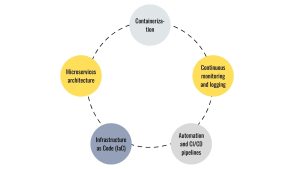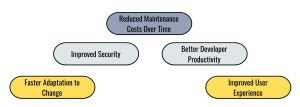Cloud-Native Maintenance: The New Standard for Software Longevity
Introduction In today’s digital age, software doesn’t just have to work – it has to last. Companies are increasingly investing in long-term solutions that can evolve with chan...

Introduction
In today’s digital age, software doesn’t just have to work – it has to last. Companies are increasingly investing in long-term solutions that can evolve with changing needs. That’s where cloud-native maintenance come in. It’s no longer just a buzzword. It’s quickly becoming the new standard for ensuring software stays relevant, secure, and scalable over time.
What is Cloud-Native Maintenance?
Before we dive in, let’s define what we mean by cloud maintenance.
Cloud-native maintenance refers to the ongoing maintenance, improvement, and management of applications built specifically for cloud environments. These applications typically use microservices, containers, and continuous integration/continuous deployment (CI/CD) pipelines. They are designed to be modular, scalable, and easily upgradeable.
Unlike traditional maintenance, which often involves manual patching and monolithic architecture, cloud-native maintenance is automated, flexible, and proactive. This shift enables faster updates, better resource utilization, and increased resilience.
Why Cloud-Native is Changing the Game
So why is cloud computing getting so much attention?
First, it provides flexibility. Companies can deploy changes quickly, sometimes even multiple times a day. No more waiting weeks or months for a new release. With cloud tools, updates happen quickly and with minimal disruption.
Second, it provides scalability. Need to handle a spike in traffic? Cloud systems can scale up instantly. Then they scale down to conserve resources and reduce costs.
Third, it improves resilience. Applications built for the cloud are better prepared for failure. If one service goes down, others continue to run. That means less downtime and a smoother experience for users.
These benefits aren’t just theoretical – they’re real benefits that companies are seeing across industries.

Core Principles of Cloud-Native Maintenance
To understand how cloud services work, it’s helpful to review their basic principles:
- Microservices architecture. Instead of a single block of code, applications are broken down into smaller, independent services. Each service handles a single task. This setup makes updates and debugging much easier. If one component fails, the entire system doesn’t fail.
- Containerization. Containers (like Docker) package software with everything it needs to run. This makes deployment consistent across environments. It also makes it easier to scale and roll back if something goes wrong.
- Continuous monitoring and logging. Real-time monitoring helps teams identify issues before users do. Logs provide detailed information, making it easier to troubleshoot and optimize performance.
- Automation and CI/CD pipelines. Automation is the backbone of cloud service. CI/CD tools automatically push changes through the testing and deployment phases. This reduces human error and speeds up development cycles.
- Infrastructure as Code (IaC). With IaC tools like Terraform or AWS CloudFormation, teams manage infrastructure using code. This makes environments repeatable and easier to update or patch.

Long-Term Benefits for Software Longevity
Now let’s look at how cloud maintenance supports software longevity.
- Faster Adaptation to Change. Markets change. Technologies evolve. User needs evolve. Cloud-native maintenance helps software adapt quickly. Teams can implement features, fix bugs, and respond to trends without redesigning the entire system.
- Improved Security. Security is a major concern. Cloud environments support continuous security monitoring. Automated patching ensures vulnerabilities are quickly fixed. Additionally, containerization limits the spread of threats.
- Reduced Maintenance Costs Over Time. Cloud development may seem expensive at first. But over time, it pays off. Modular design, automation, and better resource utilization mean fewer surprises and lower operating costs.
- Better Developer Productivity. Cloud practices streamline workflows. Developers spend less time fixing old code and more time building new features. This improves morale and accelerates innovation.
- Improved User Experience. Frequent, seamless updates result in better performance and reliability. Users enjoy a smoother experience, which builds trust and loyalty.

Real-World Use Cases
Many leading companies have already adopted cloud-based services:
- Netflix runs hundreds of microservices in the cloud to deliver high-quality streaming at scale.
- Spotify uses containerization and CI/CD to deploy new features to millions of users every week.
- Airbnb uses cloud tools to ensure its platform is reliable even during peak travel seasons.
These examples show how cloud practices directly support business success.
Challenges to Consider
Of course, maintaining cloud computing isn’t without its challenges.
- Steep learning curve: Teams need time to master new tools and techniques.
- Initial investment: Building cloud systems from scratch can be expensive.
- Managing complexity: With more moving parts, the need for coordination and monitoring increases.
However, with the right strategy and training, these obstacles are surmountable. In fact, many companies find that the long-term benefits far outweigh the short-term challenges.

How to Get Started
Thinking about moving to the cloud? Here’s a roadmap:
- Assess your current infrastructure: Understand what you have and where the gaps are.
- Start small: Move one service or application to the cloud using containers.
- Implement monitoring tools: Gain insight into performance, errors, and usage.
- Automate early: Implement CI/CD pipelines and test automation from the start.
- Educate your team: Invest in developing skills for DevOps, cloud platforms, and microservices.
- Review and iterate: Continuously improve based on feedback and performance data.
Conclusion
Cloud service is more than just a trend. It is a transformative approach to managing software in a fast-paced, always-on world. It promotes agility, improves security, and supports long-term scalability.
As companies strive for longevity and sustainability, adopting cloud practices is not optional – it is essential. By making this transition, companies can future-proof their software, delight their users, and remain competitive for years to come.